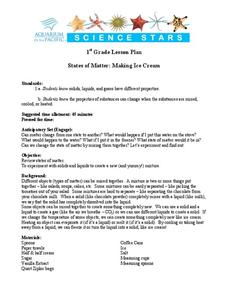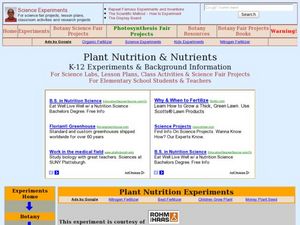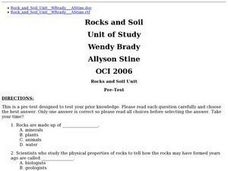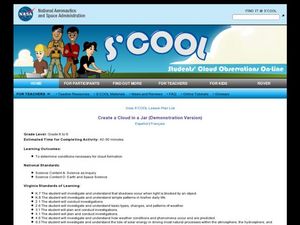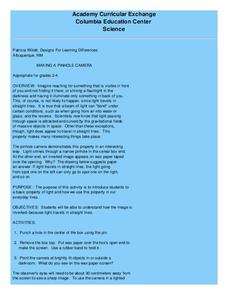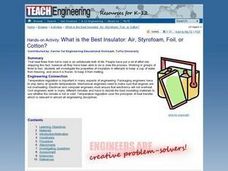Curated OER
Weather, Climate and Atmospheric Process
Students explore Earth science by completing a could identification activity. In this weather lesson, students discuss the different forms of measurement for the weather of Earth. Students discuss global warming and examine a list of...
Curated OER
Let's Take a Rock Apart!
Learners examine a crushed rock and sort the minerals they find in that rock by color and other properties.
Curated OER
How a Liquid Changes to a Gas
Second graders identify three forms of matter- solids, liquids, and gases with 100% accuracy. They observe water evaporating from an open container and water evaporating and condensing in a closed container. The students assess that a...
Curated OER
Measuring the Heat Energy of a Chemical Change
Students investigate the Law of Conservation of Energy and the relationship between heat and temperature. In this heat energy and chemical changes lesson, students observe a candle heating a paper cup of water and make predictions about...
Curated OER
Making Ice Cream
First graders create ice cream in class. In this matter lesson, 1st graders discover solids, liquids and gases and the properties of each. Students produce a batch of ice cream in class using household items.
Curated OER
Chapter 3 Worksheet Matter
In this matter worksheet, students answer ten questions about matter including the phase of matter, mixtures and how they are different from compounds, the physical and chemical properties of matter and the difference between homogeneous...
Curated OER
Plant Nutrition and Nutrients
Students observe seeds growth and examine the different parts of the seedling. In this biology lesson, students compare the growth of seeds planted in soil and in hydroponics. They record their observations in their science journal and...
Curated OER
ExplorA-Pond: 5th Grade Soil Erosion
Fifth graders visit a pond or a stream and find areas of the shoreline with vegetation and without. They pour buckets of water down each and observe the effect plants have on soil erosion. They draw and record results in a lab booklet.
Curated OER
Floodplain Modeling
Students simulate the impact of fluctuating river volumes on structures and landforms. They experiment with table top-sized riverbed models and water. Students consider how human design can help mitigate the effects of a flood.
Curated OER
Hot Cans and Cold Cans
Learners investigate the physics of heating and cooling through conduction, convection, and radiation. Working in groups, they determine the best way to cool a can of water and warm a can of water. Temperature is taken at five minute...
Curated OER
States of Matter
In this matter activity, learners read a chart that uses water to show the three most common states of matter. Students review the properties of solids. This activity has 2 graphic organizers and 8 fill in the blank questions.
Curated OER
Physical and Chemical Change of Six White Substances
Students investigate chemical and physical changes in reactions. In this chemical and physical change lesson plan, students mix 6 different white substances with water, vinegar and iodine. They make hypotheses about each substance and...
Curated OER
Change of State
Students investigate the change of states of Butyl Stearate and the temperatures at which it changes state. In this change of state lesson plan, students place a test tube of Butyl Stearate in a cold water bath and monitor its...
Curated OER
Rocks and Soil
Learners explore the physical properties of rocks. They explore the three different types of rocks and are able to compare and contrast their different properties. Students simulate the creation of sedimentary rock, they also...
Curated OER
Create a Cloud In a Jar
Students investigate cloud formation. In this weather lesson, students examine how clouds are formed. Students participate in experiments that model how water vapor in the air works.
Curated OER
Tsunami
Students explore tsunami through various hands-on activities. In this earth science lesson, students explain how they are formed. They create tsunami and earthquake models in the lab to observe how they are generated.
Curated OER
Making a Pinhole Camera
Learners construct a pinhole camera in order to explain the basic property of the inversion of light. A well-designed and effective activity.
Curated OER
What is the Best Insulator: Air, Styrofoam, Foil, or Cotton?
Learners investigate the properties of insulators by attempting to keep a cup of water from freezing, and once it is frozen, to keep it from melting. They conduct the experiment, record and analyze the results, and answer discussion...
Curated OER
Polymers Lab: Bouncy Ball and Slime
Eighth graders investigate chemical reactions to produce polymers. In this polymers lesson plan, 8th graders experiment with sodium silicate and ethyl alcohol to make a polymer. They also experiment with borax and glue to make a polymer....
Curated OER
WS 10.2 Electrolytes and Solubility
In this electrolytes and solubility learning exercise, students answer questions about electrolytes and write balanced equations for the dissociation of salts in water. They also determine solutes that are soluble in water and write...
Curated OER
Diffusion of Molecules
Students conduct a series of experiments to observe factors that impact molecular movement. In this molecular chemistry lesson, students drop food coloring in water with different properties (hot, with ice, with alcohol) and observe how...
Curated OER
Warming by Freezing
Ninth graders discover the reasoning behind spraying water on fruit and seedlings in preparation for hard freezes. In this conceptual physics lesson plan, 9th graders conduct an experiment to measure the heat released when water goes...
Curated OER
Density Challenge
Students calculate the densities of several liquids that appear similar. In this physical science lesson, students go beyond understanding the way liquids of different densities behave to researching how this knowledge applies in real...
Curated OER
Creating the Ideal Cargo Boat
Students build boats out of clay to test the buoyancy of the boat in water. Students break into pairs and construct their boat to specific guide lines, then experiment with their boat in the water.






